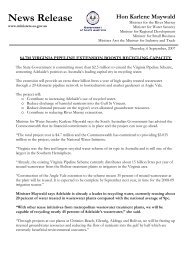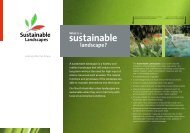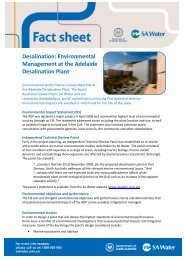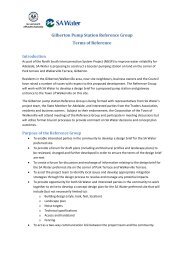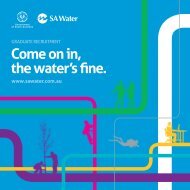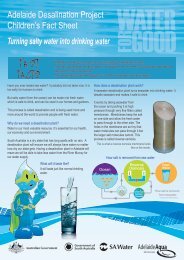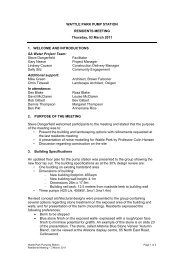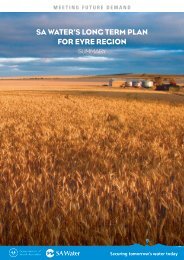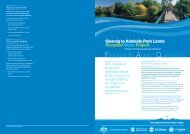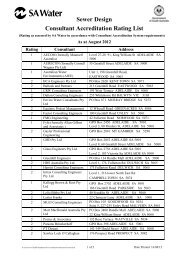Code of Practice - Irrigated Public Open Space - SA Water
Code of Practice - Irrigated Public Open Space - SA Water
Code of Practice - Irrigated Public Open Space - SA Water
Create successful ePaper yourself
Turn your PDF publications into a flip-book with our unique Google optimized e-Paper software.
5.9 Irrigation management technology<br />
In order to manage irrigation efficiently, daily monitoring<br />
<strong>of</strong> the weather and soil moisture levels is required. This can<br />
involve ongoing complex calculations and adjustment <strong>of</strong><br />
irrigation schedules to respond to the ever changing plant<br />
water requirements. Technologies have been developed to<br />
assist the irrigation manager to monitor climatic and soil<br />
moisture changes and adjust irrigation schedules<br />
automatically as required. Technologies such as<br />
computerised irrigation management systems, weather<br />
stations, soil moisture sensors and rain sensors can all<br />
improve irrigation management.<br />
5.9.1 Weather based irrigation control systems<br />
Irrigation control systems have been developed that use<br />
climatic data to calculate irrigation run times or to schedule<br />
irrigation events. Such systems are a useful tool in managing<br />
irrigation and relieve the irrigation manager from the task <strong>of</strong><br />
calculating the irrigation requirement and automatically<br />
adjust irrigation schedules as a function <strong>of</strong> the weather.<br />
Some systems are fully automatic and are linked to weather<br />
stations from which they retrieve climatic data and<br />
automatically calculate reference ETo and effective rainfall.<br />
The irrigation requirement is then calculated using preset<br />
crop co-efficient and system efficiency factors. Semiautomatic<br />
systems require manual input <strong>of</strong> a base irrigation<br />
schedule and daily input <strong>of</strong> reference ETo and effective<br />
rainfall from which the system determines the frequency <strong>of</strong><br />
irrigation events.<br />
Services are available whereby irrigation management service<br />
providers access climatic data from a network <strong>of</strong> weather<br />
stations. The data is processed by a centralised computer and<br />
transmitted to irrigation sites adjusting schedules or<br />
regulating irrigation events according to the weather.<br />
Climatic data can be accessed from either the Bureau <strong>of</strong><br />
Meteorology or from private weather stations. A significant<br />
factor in the efficiency <strong>of</strong> the control system is the quality<br />
<strong>of</strong> data used.<br />
5.0 TURF & IRRIGATION MANAGEMENT PRINCIPLES<br />
28<br />
5.9.2 Weather stations<br />
Weather stations can be installed by organisations to<br />
provide real time climatic data from which reference<br />
evaporation can be calculated. Weather stations are<br />
particularly useful for regional areas where Bureau <strong>of</strong><br />
Meteorology data is limited or for specific sites where<br />
climate data is required.<br />
Weather stations used for monitoring reference<br />
evapotranspiration (ETo) should conform to the<br />
requirements specified by the Bureau <strong>of</strong> Meteorology<br />
and in the FAO Technical Paper No 56.<br />
The following data is required;<br />
• Air temperature.<br />
• Relative humidity.<br />
• Wind speed.<br />
• Solar radiation.<br />
Weather station data is then used by the system to calculate<br />
ETo and subsequent irrigation schedules or events.<br />
5.9.3 Soil moisture based<br />
irrigation control systems<br />
Soil moisture sensors are able to directly record the soil<br />
moisture status <strong>of</strong> the soil. Information gained from soil<br />
moisture sensors provides both data on soil water reduction<br />
through ETc and a feedback loop which monitors the<br />
accuracy <strong>of</strong> climate driven irrigation schedules. The sensors<br />
record the net effect <strong>of</strong> the integration <strong>of</strong> soil, turf grass,<br />
climate and irrigation to assist with identifying indicators<br />
that drive the decision for irrigation and monitor the<br />
efficiency <strong>of</strong> irrigation.



